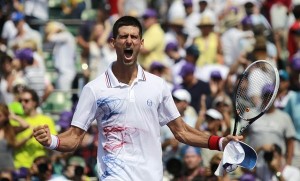There was a significant drop-off in daily TV viewership for the Sony Ericsson Open, which ended last week, but it’s not related to the declining fortunes of U.S. tennis players and, as bad as the numbers look at first blush, there’s some platinum linings in there.
That’s the conclusion of Jason Bernstein, ESPN’s senior director of programs and acquisitions, and after all the years he has spent closely monitoring the viewing habits of American tennis fans, you have to trust his insight.

“Fans are following the most meaningful matches, the best players and the best events, and sometimes when those are played in the best time zones. When top players (say Novak Djokovic of Serbia and Rafa Nadal of Spain), the top players lead to ratings success,” says Bernstein. “When Americans are in the upper echelon, we can see an even greater ratings uptick, but good ratings are not predicated on American participation.”
There’s a conventional wisdom that the success of tennis on TV in the U.S. is closely linked to the success of American players and, if you accept that, things can’t be going well right now, particularly on the women’s side, with the slow decline of the Williams sisters and no other star quality Americans flirting with the top 10.
That wisdom may have once been true, but Bernstein believes as tennis on TV has gotten more sophisticated and is now supplemented with streaming right to your computer, tennis audiences have evolved as well.
So why was the average audience for the six ESPN2 telecasts at the critical Key Biscayne tournament down 12 percent (from 301,000 to 264,000 viewers) this year? That’s a difficult question to answer, but the point is that it has nothing to do with Andy Roddick going out early and Mardy Fish going out in the quarters.
Plus, the numbers are a bit deceptive. As Bernstein pointed out, the reach was about equal to the previous year with nine million people watching the tournament at some point and the average length of time spent watching up 9 per cent from 32 to 35 minutes.
Digitally, the daily average was also down, but ESPN3 and WatchESPN delivered 95,000 unique viewers and 18.8 million minutes consumed via computers. Those minutes consumed were up 70 percent and the average time spent viewing on the computer was 198 minutes per unique viewer.
Among the things these numbers tell you is that streamed tennis has an enormous upside. In the U.S., there are essentially two ways to have tennis piped directly to your computer. One is on Tennis TV, a subscription program ($129 per year) which delivers hundreds of men’s and women’s matches per year (but no Grand Slam matches) and WatchESPN (espn.go.com/watchespn/player), which is free.
Both deliver exceptional pictures. I’ve had moments where I’ve placed my laptop on (where else?) my lap while kicking back in bed and gotten a better view of a match that if I was sitting in a typical stadium court press facility.
Plus, you have the capability of scrolling back during a streamed broadcast to look at a particularly important point or controversy.
If you accept Bernstein’s premise that matching up the best players produces the best ratings, regardless of nationality, then things seem fairly well in hand on the men’s side. What happens on the women’s side is less clear.
You’ve got four or perhaps 3.5 clear elite stars on the ATP tour with Djokovic, Nadal, Roger Federer and Andy Murray, who could be much more of a must-see tennis personality if he could win a major.
On the women’s side, Victoria Azarenka is 26-1 with four titles in five tournaments this year, including the Australian Open, and TV fans have a natural interest in a player who almost never loses. But TV and WTA Tour have work to do getting beyond Azarenka’s tennis. Who is she? What’s her story? Does she have a temper? Crises in her life? She needs a third dimension and she needs a rivalry.
Djokovic, on the other hand, was already something of a personality with non-tennis fans, but when he did a segment on 60 Minutes two weeks ago about his childhood in war-torn Yugoslavia, which was watched by millions, he literally boomed off the screen. That’s the sort of publicity that will punch up tennis viewing on TV.
For Azarenka, who is from Belarus, she can be a strong attraction. But she needs a rival, probably Maria Sharapova. That would give women’s tennis the top players he’s talking about. . . except that Sharapova is going to have to do better than 6-3, 6-0 and 6-2, 6-3 — the scores of her last two losses to Azarenka.
If those daily viewing numbers don’t increase right away, it won’t be for lack of effort. Bernstein and WTA president Stacy Allaster have a close working relationship. “She’s always looking for ways to grow the sport, whether we’re having a standing dialogue or an off-the-cuff conversation at Indian Wells or Australia. We have these conversations regularly and we’re not shy about offering opinions,” said Bernstein.
Azarenka, Sharapova, Caroline Wozniacki, Djokovic, Nadal, Federer . . . none of them are Americans, but that’s OK. We’re all evolving a bit in our viewing habits. We’re all better understanding that tennis is a global sport and that, while it would be great to have some Americans in the elite mix, the No. 1 object here is good tennis — no matter where the players come from.
Charles Bricker can be reached at nflwriterr@aol.com
